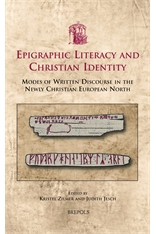 Epigraphic Literacy and Christian Identity: Modes of Written Discourse in the Newly Christian European North, ed. Kristel Zilmer and Judith Jesch (Turnhout, 2012: USML 4), vi+273 pp. ISBN 978-2-503-54294-2.
Epigraphic Literacy and Christian Identity: Modes of Written Discourse in the Newly Christian European North, ed. Kristel Zilmer and Judith Jesch (Turnhout, 2012: USML 4), vi+273 pp. ISBN 978-2-503-54294-2.
This volume examines the role of epigraphic literacy within the newly introduced Christian culture and the developing tradition of literacy in Northern Europe during the Viking Age and the High Middle Ages. The epigraphic material under scrutiny here originates from Scandinavia and North-West Russia – two regions that were converted to Christianity around the turn of the first millennium. Besides traditional categories of epigraphic sources, such as monumental inscriptions on durable materials, the volume is concerned with more casual inscriptions on less permanent materials. The first part of the book discusses a form of monumental epigraphic literacy manifested on Scandinavian rune stones, with a particular focus on their Christian connections. The second part examines exchanges between Christian culture and ephemeral products of epigraphic literacy, as expressed through Scandinavian rune sticks, East Slavonic birchbark documents and church graffiti.
The collective purpose of the nine essays is to look beyond the traditional sphere of parchment literacy and the Christian discourse of manuscript sources in order to explore the role of epigraphic literacy in the written vernacular cultures of Scandinavia and North-West Russia. The contributions in this volume seek out evidence that reveal the internal and conscious communication of Christianity with the aim of creating and maintaining particular identities, outside of formal and nominal manifestation of Christian connections. The various essays emphasize the importance of including both monumental and ephemeral types of evidence, analysing the domains and uses of epigraphic literacy in the communication of Christianity in the period from the late tenth to the early thirteenth century.
Contents:
Kristel Zilmer, “Epigraphic Literacy and the Communication of Christian Culture in Northern Europe”
Part I: Runic Literacy and Christian Connections in the Context of Scandinavian Rune Stones
Magnus Källström, “Clerical or Lay Literacy in Late Viking Age Uppland? The Evidence of Local Rune Carvers and Their Work”
Laila Kitzler Åhfeldt, “Carving Technique and Runic Literacy”
Kristel Zilmer, “Christianity in Runes: Prayers in Scandinavian Rune Stone Inscriptions from the Viking Age and the Early Middle Ages”
Henrik Williams, “‘Dead in White Clothes’: Modes of Christian Expression on Viking Age Rune Stones in Present-Day Sweden”
Part II: Exchanges between Christian Culture and Practical Modes of Correspondence in Scandinavia and Northwestern Russia: Rune Sticks, Birchbark Documents and Church Graffiti
Michael Schulte, “Pragmatic Runic Literacy in Scandinavia c. 800-1300: With a Particular Focus on the Bryggen Material”
Terje Spurkland, “How Christian Were the Norwegians in the High Middle Ages? The Runic Evidence”
Jos Schaeken, “The Birchbark Documents in Time and Space – Revisited”
Alexej Gippius, “Birchbark Literacy and the Rise of Written Communication in Early Rus’”
Tatjana Rozhdestvenskaja, “Written Culture of Medieval Novgorod in the Light of Epigraphy”

